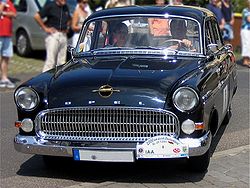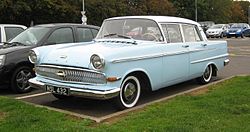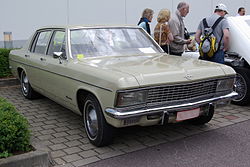- Opel Kapitän
-
Opel Kapitän Manufacturer Opel Production 1939–1970 Predecessor Opel Super Six Successor Opel Senator Class Full-size luxury car Body style 4-door sedan Layout FR layout Related Opel Diplomat
Opel AdmiralThe Opel Kapitän was a car made in several different generations by the German car manufacturer Opel from 1938 to 1970.
Contents
1938–40
First generation 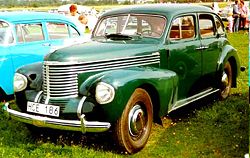
Production 1938–1940 Engine 2.5 l-I6[1] Transmission 3-speed manual The Kapitän was the last new Opel model to appear before the outbreak of the Second World War, developed during 1938 and launched in the spring of 1939 at the Geneva motor show. The first Kapitän was available in many different body styles, the most popular one being the 4-door saloon. 2-door coupé cabriolets were also built. The pre-war Kapitän featured a unitary body, a modern feature for its time. The car inherited its 2.5 litre engine from its predecessor: in this application a maximum speed of 118 km/h (73 mph) was reported.[1]
Civilian automobile production by Opel ceased in the Fall / Autumn of 1940, by which time 25,371 Kapitäns had been produced: a further three were assembled during 1943, giving a total production volume for the version launched in 1939 of 25,374. In addition, 2 were assembled in 1946, and one in 1947, but these were not officially recorded in the statistics.
Included in the production total were 248 of the two seater cabriolets built for Opel by independent coach builders Gläser of Dresden and Hebmüller of Wülfrath in Wuppertal. There would, however, be no resurrection for the cabriolet Kapitäns in 1948 when the sedan / saloon version was reintroduced.
1948–50
Second generation 
Production 1948–1950 Engine 2.5 l-I6, 55 PS/54 hp Transmission 3-speed manual Wheelbase 2,695 mm (106.1 in) Length 4,620 mm (181.9 in) Width 1,660 mm (65.4 in) Height 1,640 mm (64.6 in) Curb weight 1,230 kg (2,711.7 lb) In October 1948, the Kapitän was re-introduced as a large six-cylinder saloon only, based on the 1939 version. The main differences were round headlights as opposed to hexagonal ones. From May 1950 the shifter was relocated from the floor to the steering column. The first post-war Kapitän reached a top speed of 126 km/h (78.3 mph), needed 29 seconds to reach 100 km/h (62 mph) and consumed 13 litres per 100 kilometres (22 mpg-imp; 18 mpg-US) in the process.
Up to February 1951, 30.431 Kapitäns were built.
1951–53
Third generation 
Production 1951–1953 Engine 2.5 l-I6, 58 PS/57 hp Transmission 3-speed manual Wheelbase 2,695 mm (106.1 in) Length 4,715 mm (185.6 in) Width 1,720 mm (67.7 in) Height 1,625 mm (64.0 in) Curb weight 1,240 kg (2,733.7 lb) The 1951 Kapitän, introduced in March 1951, was a stylistically slightly modernized version of the old model; technically it was much the same. The engine's compression ratio rose from 6.0:1 to 6.25 to 1, its output from 55 PS (40 kW; 54 hp) to 58 PS (43 kW; 57 hp).
From the outside the car was readily distinguished from the first post-war Kapitäns, thanks to an abundance of chrome[2] and a US style grill at the front.
From March 1951 up to July 1953, Opel built 48,562 cars of this series.
1954–57
Fourth generation 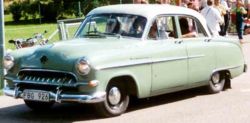
Production 1954–1957 Engine 2.5 l-I6, 68-75 PS (67-74 hp) Transmission 3-speed manual, 4-speed-overdrive transmission Wheelbase 2,750 mm (108.3 in) Length 4,710 mm (185.4 in)-4,735 mm (186.4 in) Width 1,760 mm (69.3 in) Height 1,600 mm (63.0 in)-1,560 mm (61.4 in) Curb weight 1,250 kg (2,755.8 lb)-1,300 kg (2,866.0 lb) In November 1954, Opel launched a completely new Kapitän that was longer and wider than its predecessor. Carried over was the six-cylinder engine, though its compression ratio was raised to 7.0:1, giving 68 PS (50 kW; 67 hp) initially. For 1955, output rose to 71 PS (52 kW; 70 hp) and was further enhanced to 75 PS (55 kW; 74 hp) for 1956. The ´54 featured a revised rear live axle, a rear stabilizing bar and slightly enlarged drum brakes.
Model year 1956 saw a mild facelift with a more up-to-date grille, bezeled headlamps, larger front indicator lights and revised side trim. The ´56 reached a top speed of 140 km/h (87.0 mph) and consumed 13 L/100 km (22 mpg-imp; 18 mpg-US).
From May 1957, a semi-automatic 3-speed overdrive transmission with an additional fourth gear became available on request.
From November 1953 to February 1958, 154,098 Kapitäns were built. In its time, this generation was the third most popular car in Germany behind Volkswagen´s Beetle and Opel's own Rekord (Oswald, p. 73).
Kapitän P1
Kapitän P1 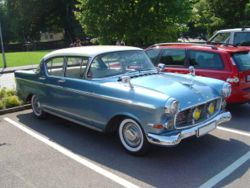
Production 1958–1959 Engine 2.5 l-I6, 80 PS (79 hp) Transmission 3-speed manual
4-speed overdriveWheelbase 2,800 mm (110.2 in) Length 4,764 mm (187.6 in) Width 1,785 mm (70.3 in) Height 1,500 mm (59.1 in) Curb weight 1,310 kg (2,888.1 lb) The 1958 Kapitän (series P1), introduced in June 1958, was both wider and lower than its predecessor, and featured panoramic windows. It was only built for one year. This time, the 2.5 l-six's output was raised to 80 PS (59 kW; 79 hp). Wheelbase, track widths, length and width were all slightly stretched, while a flatter roof made the car some 6 centimetres (2.4 in) lower.
From June 1958 to June 1959, 34.282 cars were built.
Kapitän P2
Kapitän P2 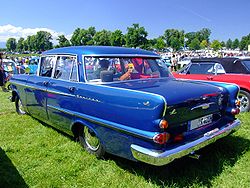
Production 1959–1963 Engine 2.6 l-I6, 90 PS (89 hp) Transmission 3-speed manual
4-speed overdrive
3-speed Hydra-Matic-automaticWheelbase 2,800 mm (110.2 in) Length 4,831 mm (190.2 in) Width 1,812 mm (71.3 in) Height 1,512 mm (59.5 in) Curb weight 1,340 kg (2,954.2 lb) The P2 Kapitän came to market in August 1959 and while it still had the panoramic windscreen, it gained a new grille and a redone body with a more angular roof and a new rear. It was driven by a stronger new, oversquare 2.6 liter-inline six (bore x stroke: 85 x 76.5 instead of 80 x 82 mm), still of OHV and pushrod design. Carried over were the 3-speed and 4-speed overdrive transmission; the latter was replaced from December 1960 by a version of GM´s 3-speed Turbo-Hydramatic automatic.
The P2 climbed to a top speed of 150 km/h (93.2 mph), reached 100 km/h (62 mph) in 16 seconds and consumed 12 L/100 km (24 mpg-imp; 20 mpg-US).
From August 1959 to December 1963, Opel built 145,618 units of this Kapitän series.
The large Opels were never dominating players in their market segment on the same scale as the smaller Rekord and Kadett models, possibly due to the strength of Mercedes-Benz in the big car sector.[3] Nevertheless the highpoint for the big Opels was 1960 when together the Kapitän and Admiral were Europe's top selling six cylinder saloons, with nearly 48,000 sold.[3]
Kapitän A
Kapitän A 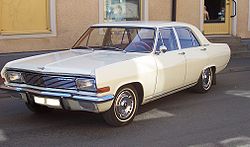
Production 1964–1968 Engine 2.6 litre 6-cylinder, 100 PS (99 hp)
2.8 l-I6, 125-140 PS (123-138 hp)
4.6 l-V8, 190 PS (187 hp)Transmission 4-speed manual
2-speed Powerglide-automaticWheelbase 2,845 mm (112.0 in) Length 4,948 mm (194.8 in) Width 1,902 mm (74.9 in) Height 1,445 mm (56.9 in) Curb weight 1,380 kg (3,042.4 lb) - 1,550 kg (3,417.2 lb) In 1964, Opel introduced the completely new KAD (Kapitän, Admiral, Diplomat) models; the Kapitän served as the base model of this three-tier model range.
It was powered by the same engines as the contemporary Opel Admiral, namely a 2.6 l-inline six or a 2.8 l-six; a few Kapitäns even received the Chevrolet-sourced 4.6 l-V8. For the Austrian market, 580 Kapitän and Admiral models received a 2.5 l-six with an output of 112 PS (82 kW; 110 hp) in 1966/67.
Like its more expensive brethren, the Kapitän was reworked in late 1967 and received rub strips, a new ZF steering and a collapsible steering column. At the same time, a new HL (Hochleistung = high performance) version of the 2.8 l-six became available that put out 140 PS (103 kW; 138 hp).
Sales of the Kapitän A fell sharply off; up to its discontinuation in November 1968, a total of 24,249 cars left the factory.
Kapitän B
Kapitän B Production 1969–1970 Engine 2.8 l-I6, 132-145 PS (130-143 hp) Transmission 4-speed manual
3-speed automaticWheelbase 2,845 mm (112.0 in) Length 4,907 mm (193.2 in) Width 1,852 mm (72.9 in) Height 1,450 mm (57.1 in) Curb weight 1,475 kg (3,251.8 lb) - 1,495 kg (3,295.9 lb) The Kapitän B was introduced in 1969 and was the last car bearing the Kapitän name. Engine options included a 1-bbl 2.8 l-inline six or a 2-bbl version of same, coupled with a 4-speed manual or Opel's 3-speed automatic transmission.
Production ended in May 1970. The Admiral and Diplomat lived on for another seven years until they were replaced by the Senator in 1978.
Just 4,976 Kapitan B models were built in 15 months.
Sources
- Werner Oswald, Deutsche Autos 1945-1976. Motorbuch Verlag, Stuttgart 1975. ISBN 3-87943-371-8.
- Phil Seeds' Virtual Car Museum
- KAD Historie
- ^ a b "Als der Fürerschein eine Mark kostet: B Busch blickt in den Rückspiegel: 1938". Auto Motor u. Sport Heft 19 1976: Seite 76–82. date 15 September 1976.
- ^ "Aller Anfang ist er". Auto Motor u. Sport Heft 13 1996: Seite 44–49. date 14 June 1996.
- ^ a b "Kurztest: Opel Diplomat". Auto Motor u. Sport Heft 15 1977: Seite 58–63. date 20 July 1977.
External links
Opel road car timeline, 1947–1970s next » Type 1940s 1950s 1960s 1970s 7 8 9 0 1 2 3 4 5 6 7 8 9 0 1 2 3 4 5 6 7 8 9 0 1 2 3 4 5 6 7 8 9 Small family car Kadett A Kadett B Kadett C Olympia Olympia Rekord Olympia A Large family car Rekord PI Rekord PII Ascona A Ascona B Executive car Rekord A Rekord B Rekord C Rekord D Rekord E Kapitän Kapitän Kapitän PI / PII Commodore A Commodore B Commodore C Luxury car Kapitän A / Admiral A / Diplomat A Kapitän B / Admiral B / Diplomat B Senator / Monza Coupé / Roadster GT Manta A Manta B Opel Current Opel
passenger carsCurrent Opel
commercial vehiclesHistoric and
discontinued modelsAdmiral • Arena • Ascona • Bedford Blitz • Blitz • Calibra • Campo • Chevette • Commodore • Diplomat • 5/12 PS "Puppchen" • 4/8 PS "Doktorwagen" • Frontera • GT • Kadett • Kapitän • Laubfrosch • Manta • Monterey • Monza • Olympia • Omega • Patentmotorwagen „System Lutzmann“ • P4 • RAK • RAK1 • RAK2 • Regent • Rekord • Senator • Signum • Sintra • Speedster • Super 6 • Tigra • 10/30 (10/35) PS • 12,3-Liter-Rennwagen • VectraMotor racing cars Concept cars Divisions and
subsidiariesOpel Eisenach GmbH • Opel Motoren Kaiserslautern GmbH • Opel Powertrain GmbH • Opel Performance Center GmbH • Opel Special Vehicles GmbHOther Founder: Adam Opel • Opel InternationalCategories:- Opel vehicles
- Vehicles introduced in 1938
- 1930s automobiles
- 1940s automobiles
- 1950s automobiles
- 1960s automobiles
Wikimedia Foundation. 2010.

